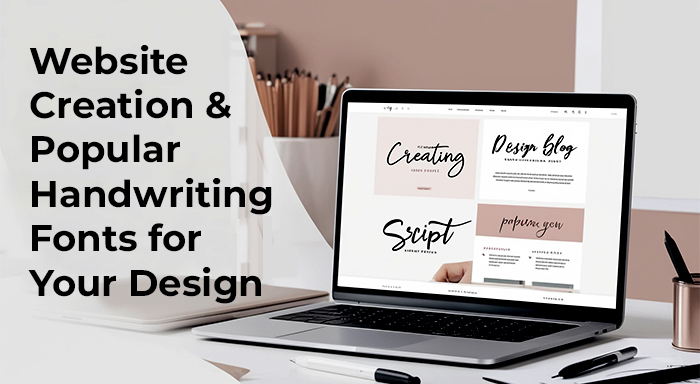In the ever-evolving world of digital design, website creation has become a crucial element for businesses of all sizes. With the rise of versatile website builders like Elementor, crafting professional and visually appealing websites is more accessible than ever. For designers looking to make their websites unique, incorporating beautiful typography, such as handwriting fonts, can add a touch of elegance and personality. Handwriting fonts can evoke warmth and familiarity, making them perfect for personal brands, creative portfolios, and even business sites looking to foster a friendly connection with their audience.
In this article, we’ll explore the role of website creation in today’s digital world and dive into the types of handwriting fonts that can elevate your design, adding charm and distinction to your web pages. If you're ready to create captivating websites, Elementor offers a powerful platform to bring your ideas to life.
Website Creation Made Easy with Elementor
Elementor is a WordPress plugin that gives you the ability to create stunning websites responsive out of the box, without having to know how to code! Ever since its launch, Elementor has become a popular choice for designers, developers, and entrepreneurs, thanks to its intuitive interface and endless amount of customizable features. It is a tool that gives users the ability to create websites fast and easily; a great balance between aesthetics and functionality and away from technical complexity.
Outright Systems, which was formed in 2010, too, has similar growth and dedication to providing solutions to clients, that meet their needs. Elementor can be a great tool for Outright Systems to start small, gradually build up a reputation for hard work and reliability, and then create websites that differentiate their company from the rest, propelling their clients into awareness.
Key Features of Elementor for Website Creation:
Drag-and-Drop Interface: Users can add, remove, and rearrange elements using Elementor’s intuitive drag-and-drop editor. It’s quick to learn, easy to get started with, and still provides a good amount of advanced options for the more experienced designer.
Responsive Design: Elementor lets you build websites that look good on both desktops, tablets, and smartphones. Responsive settings on the platform enable different settings for each device, which makes it easy for the users to adapt to any platform in use.
Pre-Designed Templates: With a library of highly professionally designed templates, Elementor allows you to start in no time. These templates can be customized with the styling to match the users’ custom branding, or perhaps more likely, used to create their own layouts.
Advanced Typography Controls: Here Extensive typography settings from Elementor come into play as it provides you the ability to add custom fonts or get from a group of font styles. This is particularly helpful for incorporating unique handwriting fonts into your design, adding a personalized touch to your content.
Integration with Handwriting Fonts: Elementor is compatible with custom font files such that users can simply add handwriting fonts to their site, giving an entirely handcrafted feel to their site. Plus, this feature is a great one for designers who want to add their personalities to their website without damaging their professionalism.
The Appeal of Handwriting Fonts in Web Design
With handwriting fonts, a website’s design feels more personal and more authentic. They also look like hand-written text, giving us a warm, organic feeling vibe. Using these fonts, designers can give their brand its own identity, from the normal typefaces, something special with a bit of character to different elements on the site.
Types of Handwriting Fonts
There is a diverse range of handwriting fonts available for web design, each with its unique style and personality. Here’s an overview of some popular types of handwriting fonts that work well for websites:
Cursive Fonts: Cursive fonts mimic the fluidity of cursive handwriting by so doing. Such brands make for elegant and refined brands, as well as wedding websites and artistic portfolios. For instance, Great Vibes, Dancing Script, and Allura can be used as font examples.
Calligraphy Fonts: These often have flourished and stylized letterforms inspired by traditional calligraphy. These are classy and creative so it is appropriate if designing a design-oriented website or event planning service is your business. Alex Brush, Pacifico & Edwardian Script are the most popular calligraphy fonts.
Brush Fonts: Brush fonts seem more like they were written with a paintbrush. They’re also fun fonts that bring more playfulness to a website. Other examples include Brush Script, Freestyle Script, and Pacific Ink.
Signature Fonts: Signature fonts have an elegant and approachable feel, with the appearance of personal signatures. And personally, most bloggers, personal brands, and influencers have taken to using this because they want a refreshing, personalized feel to their website. Examples of such signatures are Signature, Autography, and Mistral.
Comic Fonts: Comic Style fonts are a bit informal and a little whimsical and are perfect for children’s sites, blogs, and any design that needs a playful vibe. Comic Sans, Luckiest Guy, and Permanent Marker are all examples of comic fonts.
Sans-Serif Handwritten Fonts: Sans-serif handwritten fonts are clean, minimalist fonts with no frills and no personality. Versatile and they are great for all types of websites ranging from portfolio to business sites. Architect’s Daughter, Patrick Hand, and Indie Flower are among the examples.
How to Choose the Right Handwriting Font for Your Website
When choosing a handwriting font, it’s essential to consider the tone and purpose of your website. Here are some tips for selecting the best font:
- Match the Brand Voice: Choose a font that aligns with the personality of your brand. For example, a calligraphy font may be ideal for a wedding planner, while a bold brush font might suit a graphic designer.
- Ensure Readability: While handwriting fonts add flair, they can sometimes be hard to read, especially in smaller sizes. It’s crucial to balance aesthetics with readability to ensure the font does not distract or frustrate visitors.
- Use Sparingly: Handwriting fonts work best as accent text rather than for large blocks of content. Use them for headings, taglines, or call-to-action buttons, allowing standard fonts for body text to maintain readability.
- Responsive Compatibility: Always test the font on different devices to ensure it looks good on mobile, tablet, and desktop views. Elementor’s responsive settings make this process straightforward, enabling you to adjust font size and spacing for each device.
- Test Multiple Fonts: Sometimes, finding the perfect font requires experimentation. Elementor allows you to preview different fonts in real-time, so try out several handwriting fonts before making a final decision.
Integrating Handwriting Fonts with Elementor
Elementor’s advanced typography settings make it easy to integrate handwriting fonts into your website design. Here’s how you can start using these fonts with Elementor:
- Add Custom Fonts: Elementor supports custom fonts, allowing you to upload font files and use them within the editor. This feature is beneficial for designers who want to use unique handwriting fonts not available in the default options.
- Use Google Fonts: Elementor has built-in access to Google Fonts, which offers a variety of handwriting fonts for free. Simply go to the typography settings, select your desired font, and apply it to the text elements of your choice.
- Style and Customize: Once you’ve selected your handwriting font, Elementor provides options to adjust font size, weight, letter spacing, and line height. This customization helps you achieve the desired look and feel for your text.
- Create Accent Elements: Use handwriting fonts for accent elements, such as headings, quotes, or call-to-action buttons. These areas are typically more visible, allowing the font’s personality to shine without overwhelming the page.
- Incorporate Motion and Animation: Elementor includes animation settings that can add dynamic movement to text. For example, you could have a handwritten font “fade in” as users scroll, drawing attention to specific sections.
The Power of Combining Website Creation & Handwriting Fonts
Handwriting fonts offer a powerful way to add a unique touch to your website design. Whether you’re creating websites for businesses, blogs, portfolios, or personal brands, using these fonts thoughtfully can enhance the overall aesthetic and help establish a distinct brand voice.
Elementor’s easy-to-use interface makes building sites unique as easy as can be. You can combine beautiful typography, dynamic features, and responsive layouts while retaining creative control of the project. You can create a website that will be appealing to the eye and memorable using carefully selected handwriting fonts combined with Elementor’s powerful features.
Final Thoughts: Enjoy Handwriting Fonts in Your Web Design
How website creation has evolved and Elementor turned this into an easy, streamlined process of building a unique, professional website you can be proud of. Handwriting fonts add another layer of personalization and can be pretty powerful when brands want to reach their audience on a more personal level. With the right handwriting font you choose, you can also show the personality of your brand, attract users, and leave a lasting impression.
If you’re ready to take your website to the next level, take a look at the typography of the handwriting fonts and see them bring your design to a whole new degree of coolness. If you want to build beautiful and functional websites without having to write a line of code, you want Elementor for that. If you are a beginner or seasoned designer you can explore Elementor typography features today. Test for yourself why it’s a loved one by designers, creating websites can not be more customizable and exciting!



